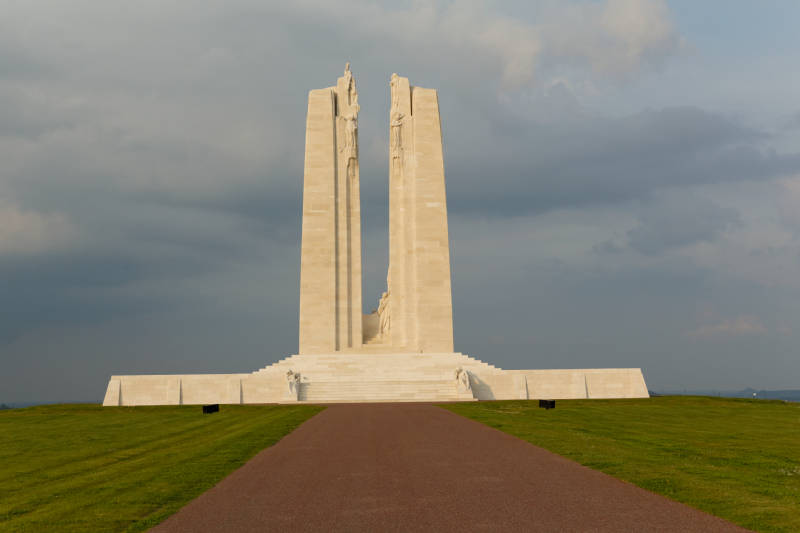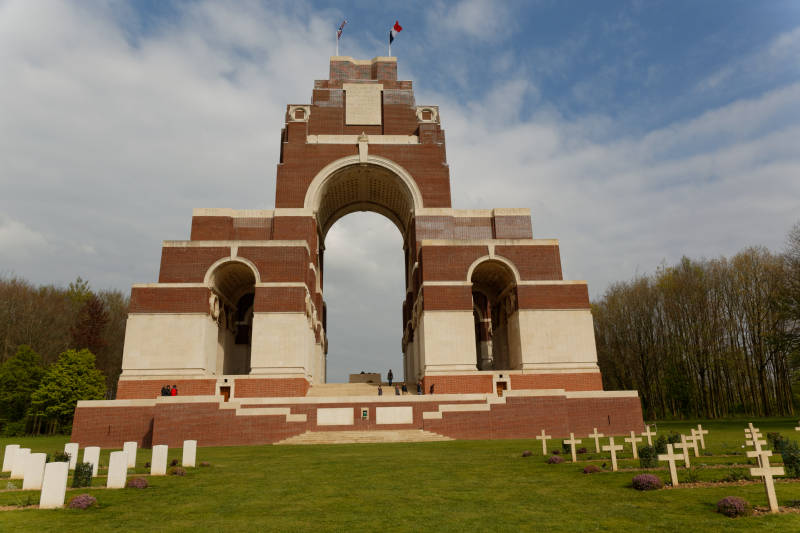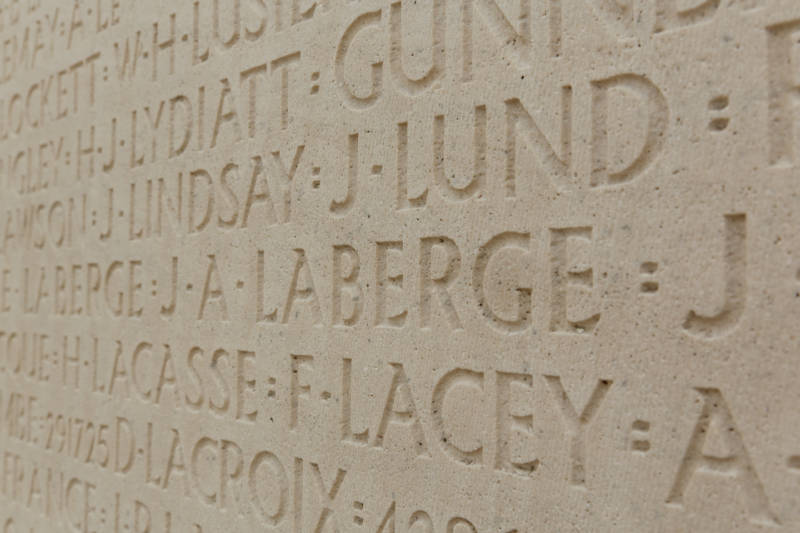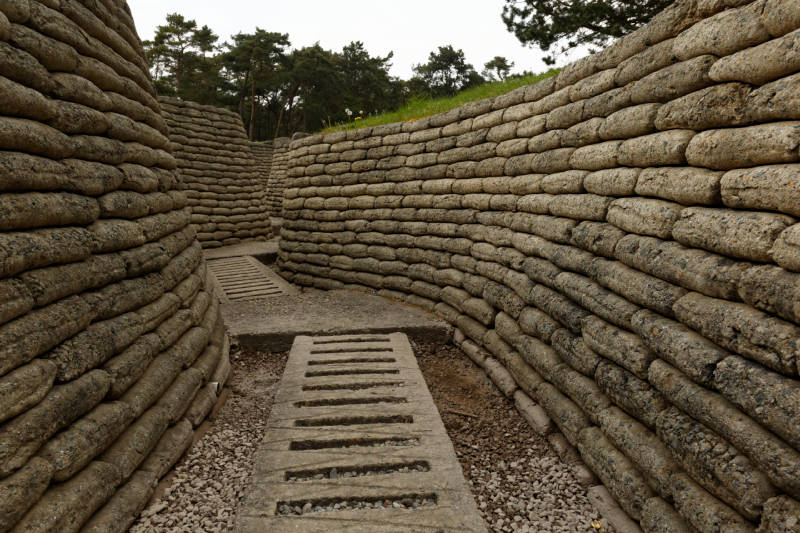
Canadian Memorial, Vimy. Image by Jean-Bernard Carillet / Lonely Planet
One of the most famous WWI memorials in northern France is Thiepval, 160km north of Paris. Designed by the colonial architect Edwin Lutyens, this arch-shaped construction was built on the site of a German stronghold that was stormed on 1 July 1916, the first day of the Battle of the Somme. This notorious date is still known as the ‘bloodiest day of the British army’; by nightfall, more than 40,000 British soldiers had been killed, injured or taken prisoner. At a height of 45m, this is the largest British war memorial in the world, and more than 73,000 names of missing British soldiers are engraved in the stone pillars of the colossal arch. The site also has a large Commonwealth cemetery and an informative visitors' centre.
The five thousand Ulstermen who perished in the Battle of the Somme are commemorated nearby at the Ulster Memorial, a replica of Helen’s Tower at Clanboye in County Down, where the Ulster Division trained. The memorial stands near Thiepval Wood.

Thiepval Memorial to the Missing of the Somme. Image by Jean-Bernard Carillet / Lonely Planet
During WWI, 46,000 Australians perished on the Western Front, many in the battles fought near Pozières and Villers-Bretonneux in Picardy. A visit to the Musée Franco-Australien (Franco-Australian Museum) in Villers-Bretonneux is an excellent starting point to understanding the role of the Australian troops in the conflict.
About 2km north of town, the 32m-high Australian National War Memorial, designed by the British architect Lutyens, is one of the most imposing memorials in the Somme. The names of 10,982 Australian soldiers are engraved on the base of the monument, and a viewing platform looks out over a sea of Commonwealth graves. The Anzac Day Dawn Service is held here every 25 April at 5.30am.
Inaugurated in 2008, the Australian Corps Memorial Park is 7km northeast of Villers-Bretonneux. It stands on the hilltop site of the Battle of Le Hamel, which was fought and won by Australian troops on 4 July 1918. In its 93 minutes more than 1000 Australians and Americans were killed or wounded. The memorial comprises three curving walls clad in green granite. The central slab is adorned with a large bronze ‘Rising Sun’, the badge worn by members of the Australian Imperial Force.
Another moving site is the Fromelles (Phaesant Wood) Military Cemetery, 17km west of Lille, which was established in 2010 following the discovery of the mass graves of 250 Australian soldiers. Just 2km northwest, the Australian Memorial Park marks the spot where, on 19 and 20 July 1916, a total of 1917 Australian soldiers were killed during a poorly planned offensive intended to divert German forces from the Battle of the Somme.

Canadian Memorial, Vimy. Image by Jean-Bernard Carillet / Lonely Planet
Vimy Ridge, 8km north of Arras, was the scene of some of the bloodiest trench warfare of WWI, with almost two full years of attacks. Of the 66,655 Canadians who died in WWI, 3598 lost their lives in April 1917 taking this heavily fortified German position. It’s an evocative site; part of the crater-pocked battlefield was preserved exactly as it was found at the end of the fighting. The zigzag trench system is clearly visible, as are countless shell craters. On the edge of the ridge, overlooking the plain of Artois, a gleaming white monument reaches for the heavens; the names of 11,285 Canadians whose bodies were never found are inscribed around its base. The well-organised visitor centre runs free guided tours.
Another site that preserves part of the Western Front is Beaumont Hamel Newfoundland Memorial, 9km north of Albert. Here, on 1 July 1916, the Royal Newfoundland Regiment was nearly wiped out during a massive assault. The site was left as it was when the guns fell silent, and a network of trenches, now covered with grass, is still clearly visible.

Restored trenches in Vimy Memorial Park, France. Image by Jean-Bernard Carillet / Lonely Planet
The United States remained neutral for the first 2½ years of WWI, but in April 1917, after German U-boats began targeting American merchant vessels heading to the UK, the United States declared war on Germany. By October 1917 American infantry units were fighting in northern France, and by the end of the war 1.2 million members of the American Expeditionary Force were stationed on French soil.
The Somme American Cemetery, 150km northeast of Paris near the village of Bony, stands on the site of an American assault on the Hindenberg Line in late September 1918. About 175km southeast, American dead from the bloody Meuse-Argonne Offensive during the last six weeks of the war are buried in the Meuse-Argonne American Cemetery, the largest American cemetery in Europe. At the Montfaucon American Monument, 11km south of the Meuse-Argonne cemetery, a huge Roman column towers over the remains of a French village destroyed in the fighting.
The St-Mihiel American Cemetery, 45km southeast of Verdun, marks the site of the Battle of St-Mihiel, where 7000 US servicemen were killed or injured in September 1918. This engagement is also commemorated at the Butte de Montsec, 15km southwest of the cemetery, where a classical circular colonnade, in white limestone, stands atop a tall hill.
More than 1.3 million French soldiers perished between 1914 and 1918, and the most important and evocative memorials to France's tremendous losses are scattered in the hills around the Lorraine town of Verdun, 260km northeast of Paris. For over 300 days, from February to December 1916, German attempts to take Verdun - and 'bleed France white' - resulted in the firing of an estimated 26 million artillery shells, and the deaths of some 360,000 French soldiers and 340,000 Germans.
France's most solemn WWI memorial, the Ossuaire de Douaumont, serves as the final resting place of about 130,000 unidentified French and German soldiers whose remains were found jumbled together at the end of the conflict. Starting in 1927, the bodies were reinterred here in 52 mass graves, each representing a different sector of the battlefield. The site is dominated by a 46m-high belltower and adjacent is a French military cemetery with over 16,000 gravestones.
In June 1916 two companies of French infantry waiting to 'go over the top' were wiped out by a massive German artillery bombardment. Three years later someone noticed several hundred bayonets sticking out of the ground - the French soldiers had literally been buried alive. Now a memorial, the site, known as the Tranchée des Baïonnettes (Bayonette Trench), was left as it was found.
The Mémorial de Verdun sits amid the ruins of the village of Fleury, completely demolished during the ferocious fighting of 1916. It will be undergoing a total renovation until late 2015.